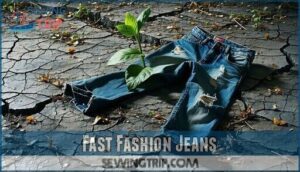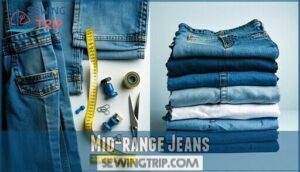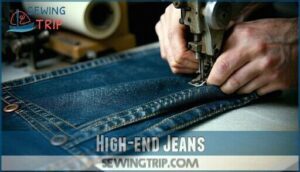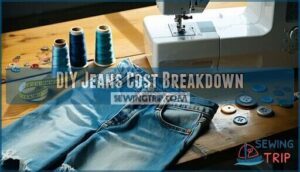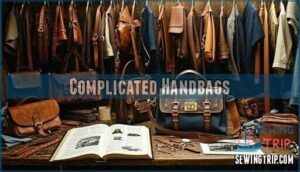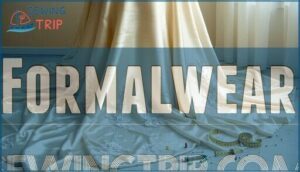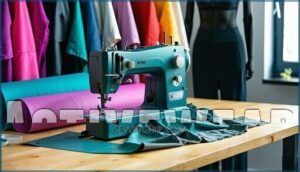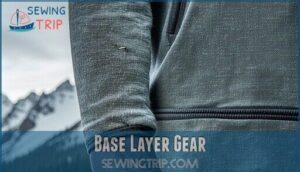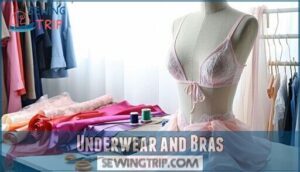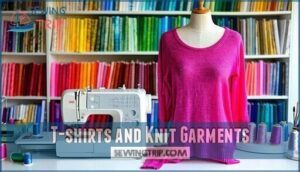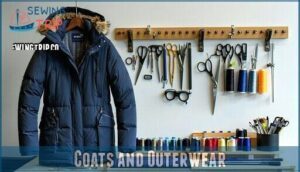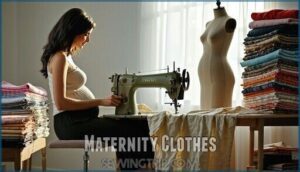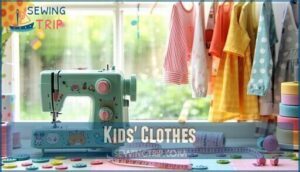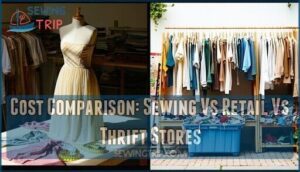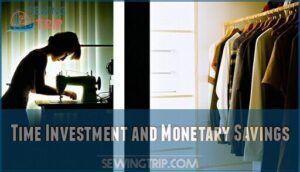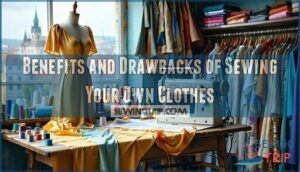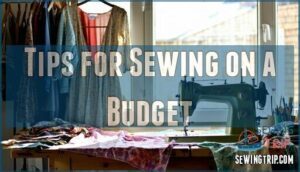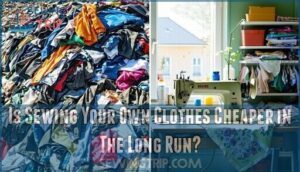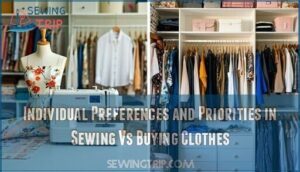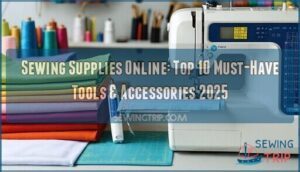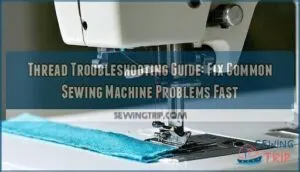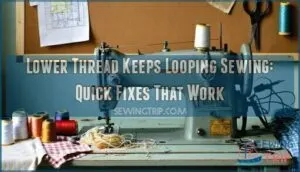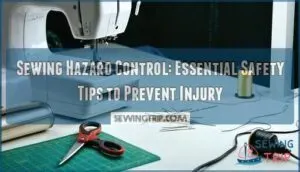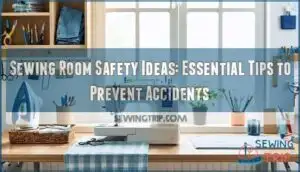This site is supported by our readers. We may earn a commission, at no cost to you, if you purchase through links.
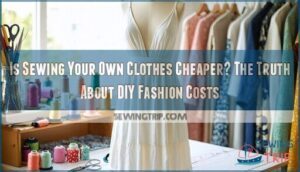 Is sewing your own clothes cheaper? It depends on your priorities and what you’re comparing against.
Is sewing your own clothes cheaper? It depends on your priorities and what you’re comparing against.
You’ll typically spend $40-80 on materials for a basic dress that takes 8-12 hours to make, while a similar store-bought version costs $25-120.
Quality fabric alone can cost $15-30 per yard, plus patterns, notions, and your time investment.
You’ll save money on expensive items like custom-made blazers or kids’ clothes they’ll quickly outgrow, but don’t expect to beat fast fashion prices—materials often cost more than a $15 H&M top.
The real savings come from creating higher-quality garments that last longer and fit better. Smart fabric choices and strategic project selection make all the difference in your bottom line.
Table Of Contents
- Key Takeaways
- Cost Comparison of Sewing Vs Buying Clothes
- Case Study: Denim Jeans
- Considerations for Sewing Specific Clothing Types
- Cost Comparison: Sewing Vs Retail Vs Thrift Stores
- Time Investment and Monetary Savings
- Sustainability and Ethical Considerations in Sewing Clothes
- Benefits and Drawbacks of Sewing Your Own Clothes
- Tips for Sewing on a Budget
- Is Sewing Your Own Clothes Cheaper in The Long Run?
- Individual Preferences and Priorities in Sewing Vs Buying Clothes
- Frequently Asked Questions (FAQs)
- Conclusion
Key Takeaways
- You’ll typically spend more on materials than fast fashion prices – expect $40-80 for a basic dress that takes 8-12 hours to make, while similar store-bought versions cost $25-120
- You’ll save money on expensive items like custom blazers and kids’ clothes – your DIY costs often beat mid-range and luxury brands by 20-50%, especially for garments they’ll outgrow quickly
- Quality fabric alone costs $15-30 per yard – when you factor in patterns, notions, and specialized materials, you’re investing in higher-quality garments that last longer than mass-produced alternatives
- The real savings come from durability and custom fit – handmade clothes typically last 3-5 times longer than fast fashion, making your cost-per-wear significantly lower despite higher upfront expenses
Cost Comparison of Sewing Vs Buying Clothes
Looking at the cost comparison between sewing and buying clothes reveals that it’s not always as straightforward as you might expect.
While sewing can offer savings on certain garments like jeans and button-up shirts, it often costs more than fast fashion when you factor in quality materials and your time investment.
Looking at this comprehensive analysis, here’s a concise blockquote that captures the key tension:
**Sewing beats retail on quality, but your wallet might disagree with fast fashion prices.
Construction Method / Garment Quality
Quality construction transforms raw materials into lasting garments.
When you sew, you control every stitch, creating durable seams that outperform fast fashion.
Professional finishing techniques like French seams and flat-felled seams increase durability factors substantially.
Considering the fabric type is essential, as selecting the right seam finish options can greatly impact the garment’s longevity and appearance.
Your handmade wardrobe expenses pay off through superior stitch types and fabric manipulation, making sewing versus buying a worthwhile investment.
| Construction Aspect | Homemade Quality | Fast Fashion Quality |
|---|---|---|
| Seam Quality | Reinforced, carefully finished | Often weak, fraying edges |
| Stitch Types | Appropriate for fabric/use | Generic, speed-focused |
| Finishing Techniques | French seams, proper pressing | Raw edges, minimal finishing |
| Durability Factors | Built to last decades | Designed for temporary wear |
| Overall Investment | Higher upfront, lower long-term cost | Cheaper initially, frequent replacement |
Fabric Costs
Fabric costs make or break your sewing budget, with prices ranging from $2 for basic polyester to $300+ for luxury materials.
Natural fibers like cotton and silk typically cost more than synthetics due to fiber content and dye processes. A basic plain weave polyester fabric can cost around $2 to $5 per yard.
| Fabric Type | Price Range | Best For |
|---|---|---|
| Basic Polyester | $2-5/yard | Practice projects |
| Cotton | $7-20/yard | Everyday garments |
| Premium Silks | $70-300/yard | Special occasion wear |
Print complexity, fabric weight, and ethical sourcing substantially impact fabric prices. Quality of fabric determines your garment’s durability and appearance. When comparing sewing fabric costs to ready-made clothing, remember that manufacturers buy in bulk, securing lower fabric prices than home sewers can access.
Garment Lifespan
When you sew your own clothes, you’re not just creating garments – you’re crafting lasting investments.
Handmade clothing typically outlasts store-bought items by years, thanks to superior construction methods and careful attention to detail.
| Garment Type | Store-Bought Lifespan | Handmade Lifespan |
|---|---|---|
| Basic T-shirts | 1-2 years | 5-7 years |
| Jeans | 2-3 years | 8-10 years |
| Jackets | 3-5 years | 10-15 years |
Your fabric quality choices directly impact clothing lifespan.
Natural fibers like wool and silk naturally last longer than synthetic blends, while proper care instructions – gentle washing, air-drying – preserve fabric integrity.
Construction methods matter too: reinforced seams and quality threads create durability that mass production can’t match.
Consider wear frequency when calculating clothing lifespan cost.
A well-made dress worn monthly for five years delivers exceptional value compared to fast fashion replacements.
Plus, there’s immeasurable sentimental value in wearing something you’ve crafted yourself.
Garment Type
Different garment types present varying cost challenges when you’re weighing sewing versus buying.
Simple pieces like basic tops offer the best T-shirt Economics and Activewear Savings, while complex Formalwear Costs and Outerwear Expenses can quickly escalate your sewing project cost.
| Garment Type | Sewing Advantage | Cost Considerations |
|---|---|---|
| Basic Tops | High savings potential | Low fabric needs, simple construction |
| Jeans | Moderate savings | Higher fabric costs, hardware expenses |
| Formalwear | Often more expensive | Complex techniques, premium materials |
| Activewear | Good value | Specialized fabrics, performance features |
| Outerwear | Variable savings | Substantial fabric requirements, lining costs |
Your sewing clothes cost depends heavily on garment complexity and material requirements.
Hardware & Fastenings
Hardware and fastenings add $2-$10+ to your sewing project costs, while mass-produced garments benefit from bulk pricing. You’ll pay retail prices for quality zippers ($1.50-$5), buttons ($0.10-$3+), and snaps ($0.05-$0.50).
This hardware investment affects your total sewing material prices substantially. You can research the current metal zipper prices online.
| Fastening Type | Budget Option | Premium Option |
|---|---|---|
| Metal Zippers | $1.50 | $5.00+ |
| Buttons | $0.10 plastic | $3.00+ natural |
| Press Studs | $0.05 plastic | $0.50 metal |
| Magnetic Snaps | $1.00 basic | $2.00+ heavy-duty |
Choosing quality hardware guarantees fastening security and durability, but budget options can compromise your garment’s lifespan and hardware aesthetics.
Machine Wear and Tear
Your sewing machine quietly accumulates wear with every project, directly impacting your bottom line.
Regular maintenance costs run $75-$100 annually, while neglect leads to costly repairs averaging $50-$100 per service.
| Maintenance Task | Frequency | Cost Impact |
|---|---|---|
| Needle Replacements | Per project | $0.50-$2.00 |
| Thread Quality upgrade | Ongoing | Reduces wear 30% |
| Machine Servicing | Annual | $75-$100 |
| Repair Frequency | As needed | $50-$100+ |
Quality thread and proper care extend your sewing machine’s 5-25 year lifespan, keeping equipment costs predictable while protecting your investment.
Pattern Cost
Pattern costs can make or break your sewing budget, but smart choices keep expenses manageable.
Free patterns offer zero-cost entry points, while purchased options range from budget-friendly to premium pricing.
| Pattern Type | Cost Range | Best For |
|---|---|---|
| Free Online | $0 | Beginners, basic designs |
| PDF Patterns | $5-$15 | Intermediate sewers |
| Designer Patterns | $15-$25 | Advanced projects |
| Self-Drafted | Time only | Custom fit masters |
Consider pattern pricing alongside fabric expenses when planning your sewing budget.
Free resources help maximize material savings, while investing in quality patterns improves fit and construction.
Self-drafting eliminates design costs entirely but requires advanced skills for successful results.
Understanding pattern costs is essential for effective budgeting in DIY fashion projects, and making smart choices can significantly impact your overall expenses.
Skill Level & Interest
Your sewing skills directly impact whether DIY clothing saves money.
Your skill level determines if those fabric receipts become savings or expensive mistakes.
Beginners often waste expensive fabric through mistakes, while experienced sewers maximize every yard.
As your skill progression advances, you’ll tackle complex projects efficiently and develop personal style through creative expression.
| Skill Level | Project Success Rate | Cost Efficiency |
|---|---|---|
| Beginner | 60% | Low – material waste |
| Intermediate | 80% | Moderate – fewer mistakes |
| Advanced | 95% | High – minimal waste |
| Expert | 98% | Highest – professional results |
| Master | 99% | Maximum – teaching others |
Sewing skills development transforms an expensive hobby into cost-effective wardrobe building.
Your hobby interest level determines time investment—passionate sewers find joy worth the expense, while casual crafters might prefer purchasing ready-made items, highlighting the importance of personal style and skill progression in making DIY clothing a cost-effective option, which is a result of maximize every yard of fabric and achieving professional results.
Sustainability & Ethics Factors
Beyond skill considerations, your fabric choices directly impact both cost and conscience.
Eco friendly materials typically cost 20-50% more than conventional options, but they support sustainable fashion practices that reduce environmental impact.
| Fabric Type | Cost Premium | Ethical Benefit |
|---|---|---|
| Organic Cotton | 30-40% higher | Pesticide-free farming |
| Fair Trade Silk | 25-35% higher | Fair labor costs guaranteed |
| Recycled Polyester | 15-25% higher | Waste reduction focus |
Sustainable fabrics from ethical sourcing often match indie label pricing, making DIY competitive when you factor in green manufacturing benefits.
While conventional sewing might save money, choosing ethical production materials means you’re investing in both your wardrobe and workers’ wellbeing.
Time
Time investment in sewing projects often exceeds monetary savings when you factor in labor costs.
Consider this reality check:
| Garment Type | Sewing Hours | Hourly Value |
|---|---|---|
| Basic T-shirt | 3-4 hours | $18-24 |
| Button-up shirt | 6-8 hours | $54-72 |
| Jeans | 12-15 hours | $108-135 |
| Jacket | 20-25 hours | $180-225 |
| Formal dress | 15-20 hours | $135-180 |
Smart time management and efficiency gains come from realistic expectations.
You’re not competing with factory productivity—you’re creating something uniquely yours.
While sewing vs buying debates focus on dollars, your time spent sewing delivers skills and satisfaction that ready-made garments can’t match.
Case Study: Denim Jeans
Looking at jeans specifically helps illustrate the real costs of sewing versus buying since they’re a wardrobe staple most people own multiple pairs of.
Let’s break down what you’d actually spend on fast fashion, mid-range, luxury, and DIY denim to see where sewing makes financial sense.
Fast Fashion Jeans
At less than £7 per pair, fast fashion jeans from retailers like Primark represent the rock bottom of jeans pricing.
However, these bargain prices come with hidden costs that extend far beyond your wallet.
The denim quality suffers dramatically due to cheap fabric sourcing and rushed production methods.
While sewing costs for DIY clothing typically exceed these ultra-low prices, the eco impact of fast fashion creates lasting environmental damage.
Consider upcycling thrifted jeans through creative sewing projects instead—you’ll customize unique pieces while reducing textile waste and supporting sustainable fashion practices.
Mid-range Jeans
Quality becomes the deciding factor when choosing midrange jeans from brands like Everlane or Madewell, priced around $80-120.
These brands offer:
- Higher cotton content and better denim quality than fast fashion
- Ethical labor standards with transparent manufacturing processes
- Tailoring services for personalized fit adjustments
Sewing your own jeans with midrange fabric costs $30-40 for materials, plus notions and time investment.
While fabric costs remain lower than retail prices, midrange brands provide convenience and professional finishing.
Your cost per wear depends on how often you’ll actually reach for those perfectly fitted jeans you’ve crafted yourself.
High-end Jeans
High-end luxury denim commands premium prices, with designer labels like Vivienne Westwood charging £180 for their exclusive cuts.
These premium styles justify costs through superior fabric quality and ethical production.
| Brand | Price | Key Features |
|---|---|---|
| Vivienne Westwood | £180 | Organic cotton, recycled polyester |
| Premium Designer | £200+ | Exclusive cuts, artisan construction |
| Luxury Denim | £150-300 | High-end fabrics, sustainable materials |
However, your cost per wear skyrockets unless you’re wearing these daily.
The garment construction cost reflects quality, but sewing costs for similar materials would be substantially lower.
DIY Jeans Cost Breakdown
Now let’s break down what it actually costs to make your own jeans. The numbers might surprise you, especially when you compare DIY clothing savings to what you’d spend at the store.
Here’s what you’ll need to budget for:
- Fabric costs: Quality denim runs $15-$41 per yard, with most jeans requiring 1.2-1.5 yards
- Hardware and notions: Buttons, zippers, and specialized thread add $5-$10 to your total
- Pattern investment: Commercial jeans patterns cost $10-$20 but can be reused multiple times
- Sewing labor: At 6-8 hours of work, your time investment substantially impacts the true cost
Your out-of-pocket expense typically ranges from $35-$75 per pair, excluding labor. While this beats premium brands charging $150-$250, it doesn’t compete with fast fashion’s $20-$40 price point. However, you’re getting custom fit, denim quality control, and garment construction that often surpasses mid-range retail options.
Considerations for Sewing Specific Clothing Types
Different clothing types have varying cost-effectiveness when you sew them yourself, with some offering significant savings while others might cost more than buying ready-made.
Your decision should factor in the complexity of construction, specialized materials needed, and whether you can achieve professional-quality results at home.
Complicated Handbags
While denim jeans offer predictable costs, complicated handbags present unique financial challenges that catch many sewers off-guard.
These projects demand specialized materials and techniques that substantially impact your sewing expenses.
Cost factors that’ll make your wallet wince:
- Premium Bag Materials – High-quality leather costs $50 per square foot, while synthetic alternatives run $20 per bag
- Hardware investments – Specialized zippers, clasps, and D-rings add $10-$20 per unit to your clothing production costs
- Time reality check – Complex handbag styles require 2+ hours of skilled labor, valued at $25 per hour
- Pattern complexity – Professional PDF patterns for intricate strap designs and closure types cost $10-$30
- Learning curve expenses – Mistakes with expensive lining options and structural elements mean costly do-overs
Your DIY clothing savings diminish when material costs reach $100-$300 per bag.
Compare this to retail alternatives before committing to advanced projects requiring specialized skills.
Formalwear
Sewing formalwear rarely saves money compared to buying ready-made options.
Wedding gowns and evening wear demand expensive fabrics, intricate construction techniques, and countless hours of fastidious work.
A custom jacket requires specialized interfacing and precise pressing equipment you probably don’t own.
Luxury suits need professional-grade materials costing hundreds before you even thread your needle.
Cocktail dresses and formal shirts involve complex pattern matching and finishing techniques that challenge even experienced sewers.
Custom garments require multiple fittings and adjustments, making high-end tailoring incredibly time-intensive.
Unless you’re planning to wear your wedding dress dozens of times, the cost-per-wear calculation doesn’t work in sewing’s favor.
Activewear
While formalwear demands precision and expensive materials, activewear offers better cost-saving opportunities for home sewers.
DIY fitness gear typically costs $53-$58 per piece compared to $30-$78 for store-bought options.
The real advantage lies in customization and quality control:
- Perfect fit – Custom measurements eliminate uncomfortable bunching during workouts
- Premium fabrics – You control moisture-wicking properties and durability
- Sustainable choices – Avoid fast fashion waste while building long-lasting athletic wear.
Technical fabrics for yoga pants and sports bras range from $6-$10 per yard, making homemade activewear competitive with mid-range brands.
Your sewing costs align closely with ethical athletic wear companies while delivering superior fit and performance.
When creating DIY activewear, considering DIY fabric options is vital for superior performance and comfort.
Base Layer Gear
Performance base layers become your secret weapon when temperatures drop and you’re pushing your limits outdoors. Quality thermal insulation and moisture wicking properties make all the difference between comfort and misery during active pursuits.
Creating custom base layers offers superior garment fit compared to off-the-shelf options, though fabric choice substantially impacts your budget.
Here’s your game plan:
- Source technical fabrics – merino wool blends or synthetic moisture-wicking materials
- Measure precisely – snug fit without restriction guarantees the best layering options
- Test fabric samples – verify stretch, breathability, and thermal insulation properties
- Start simple – basic long sleeves before tackling complex designs
- Calculate true cost – factor in specialized fabric expenses versus retail prices
While sewing base layers costs more upfront than basic cotton alternatives, you’ll save money compared to premium outdoor brands. The investment pays off when your custom-fitted gear performs flawlessly during challenging conditions.
Underwear and Bras
Underwear and bras present a fascinating cost paradox.
You’ll spend $25-$27 making underwear versus $5 at mass retailers, but custom bra fittings justify the investment.
Lingerie materials like cotton and modal cost more upfront, yet superior fabric choices create longer-lasting pieces.
Advanced sewing techniques for underwire support require patience, but underwear costs pale compared to $60-$350 indie alternatives.
DIY clothing costs win when replicating luxury pieces.
T-shirts and Knit Garments
T-shirts represent the sweet spot where DIY sewing projects truly shine compared to ready-made alternatives.
Your fabric choice directly impacts both comfort and yarn costs, with cotton jersey offering the best balance of affordability and wearability. Most knit patterns require basic skills, making them perfect beginner projects that deliver professional-looking results.
- Freedom to create the perfect neckline that flatters your unique body shape
- Master your wardrobe by building a collection of tees that actually fit your torso length
- Belong to the maker community by crafting garments that reflect your personal style choices
Smart garment fit adjustments during construction eliminate the frustration of ill-fitting store-bought options. These DIY sewing projects typically cost $8-15 per shirt versus $20-40 for comparable quality ready-made versions. Your cost per wear calculations improve dramatically when you’re actually excited to wear what you’ve created, leading to better long-term value through frequent use.
Coats and Outerwear
When you’re crafting coats and outerwear, parka costs can quickly add up.
Technical jacket fabrics, insulation materials, and weather-resistant treatments command premium prices.
A custom-made jacket requires specialized coat patterns, heavy-duty zippers, and interfacing that boost expenses.
While you’ll achieve perfect fit and choose quality materials for your handmade jacket, the savings compared to retail winter gear remain modest.
Outerwear trends favor investment pieces, making DIY coat projects more about customization than cost-effectiveness.
Maternity Clothes
Maternity Wear presents unique sewing costs challenges since you’ll wear these pieces for just nine months.
With over 50% of maternity clothes discarded post-pregnancy, the investment rarely pays off.
Your Baby Bump changes rapidly, making fit adjustments constant.
Smart Maternal Fashion focuses on versatile pieces like wrap dresses and empire waist tops that evolve into Nursing Clothes.
Instead of extensive garment making, consider modifying existing clothes with belly bands or hair ties.
Pregnancy Styles work best when you prioritize comfort over construction complexity.
Rental services or secondhand maternity clothes often beat DIY wardrobe costs for temporary needs.
When sewing during pregnancy, it’s vital to review sewing safety guidelines to keep in mind.
This ensures a safe and healthy approach to maternal fashion and DIY wardrobe needs.
Kids’ Clothes
While maternity wear focuses on temporary fit changes, kids’ clothes present unique opportunities for long-term savings through strategic sewing approaches.
When you’re sewing for children, fabric choices and clothing construction become game-changers for your wallet. Smart parents know that quality handmade garments can survive multiple kids, making DIY clothing a worthwhile investment despite initial sewing costs.
- Growth-friendly patterns: Choose sewing patterns with adjustable features like elastic waists and rolled cuffs that accommodate growth spurts
- Safety-first fabric choices: Select breathable, non-toxic materials that meet clothing safety standards while remaining budget-friendly
- Multi-child strategy: Design childrenswear that works for different ages and genders to maximize cost-per-wear ratios
Kids fashion moves fast, but well-constructed pieces last longer than store-bought alternatives. You’ll find that investing in durable fabrics pays off when garments survive playground adventures and countless wash cycles.
Cost Comparison: Sewing Vs Retail Vs Thrift Stores
You’re probably wondering how sewing costs stack up against your shopping options, from clearance racks to boutique labels.
The truth is, sewing rarely beats thrift store prices but can offer significant savings compared to retail, especially when you factor in the quality and longevity of your handmade pieces.
Quality Materials and Garment Durability
Your material selection dramatically impacts your bottom line when comparing sewing costs to store-bought options.
Quality materials might cost more upfront, but they’re your secret weapon for long-term savings.
Think of premium fabrics as an investment—they’ll outlast cheaper alternatives by years, making your cost per wear plummet.
Fabric quality directly affects garment longevity.
A well-made cotton shirt using quality materials can last decades with proper care, while fast fashion equivalents might survive just a few washes.
This durability testing pays off when you calculate actual value.
When craftsmanship matters, your material selection becomes essential.
Higher-end fabrics resist pilling, fading, and stretching better than budget options.
You’ll spend less on replacements and enjoy garments that maintain their shape and appearance longer.
| Material Type | Average Lifespan |
|---|---|
| Premium Natural Fibers | 10-20 years |
| Standard Synthetics | 2-5 years |
| Budget Blends | 1-3 years |
Large Companies Vs Indie Labels
Large companies’ pricing power stems from economies of scale, but indie labels offer something mass production can’t match.
When you’re weighing Brand Comparison and Price Wars, remember that Label Transparency reveals the real Production Costs behind your clothing choices.
| Factor | Large Companies | Indie Labels |
|---|---|---|
| Production Volume | Mass production reduces per-unit costs | Small batches increase individual garment expense |
| Material Sourcing | Bulk purchasing power lowers fabric costs | Premium materials at higher prices |
| Labor Practices | Often prioritize cost over fair wages | Emphasize ethical production and transparency |
Market Trends show indie labels typically cost 30-50% more than mass-market fashion, but they’re investing in sustainable practices and quality craftsmanship.
Your sewing costs often fall between these extremes, making DIY clothing production a middle ground in today’s fashion landscape.
Everlane Cost Breakdown
Everlane’s radical Production Transparency sets them apart from traditional retailers who guard their pricing secrets like trade recipes.
Their cost breakdown reveals fascinating insights about fabric costs and labor expenses that directly impact your sewing decisions.
| Garment Type | Retail Price | Production Cost | Material Sourcing |
|---|---|---|---|
| Jeans | $98 | $28.85 | $12.78 materials |
| Cotton Shirt | $75 | $24 | Premium cotton |
| Leather Bag | $365 | $204.45 | $100.10 leather |
Their Pricing Strategy maintains 2-3x markups versus industry’s 8-10x standard, making their cost of fabric comparable to your sewing machine investment.
When calculating clothing alteration costs and cost per wear, Everlane’s transparency helps you understand whether DIY projects truly deliver savings or if you’re better off buying their ethically-made basics.
Sewing your own clothes allows for customized garment lifespan, potentially reducing long-term clothing expenses.
Independent Ethical Labels
Independent brands with ethical practices offer a middle ground between sewing costs and mainstream retail.
These companies prioritize Fair Labor Practices and Sustainable Production Methods, resulting in higher prices that often match DIY expenses.
| Brand Type | Price Range | Key Features |
|---|---|---|
| Ethical Independents | $80-$200 | Transparent Supply Chains, sustainable fabrics |
| Fast Fashion | $10-$40 | Mass production, lower fabric quality |
| DIY Sewing | $50-$150 | Custom fit, Ethical Fabric Sourcing |
When you compare cost structures, independent brands’ transparency reveals why their prices align with sewing expenses.
Their Brand Value Alignment with conscious consumers justifies premium pricing for ethical fashion choices.
Fast Fashion Prices
While independent ethical labels offer transparency, fast fashion operates on a completely different cost model that makes it nearly impossible to beat on price alone.
Fast fashion achieves rock-bottom prices through mass production and labor exploitation, creating a challenging cost comparison for home sewers.
| Fast Fashion Item | Price | DIY Cost | Key Factor |
|---|---|---|---|
| Basic T-shirt | $5-10 | $15-25 | Material quality |
| Jeans | $15-30 | $40-60 | Construction complexity |
| Dress | $20-40 | $35-65 | Trend cycles |
| Jacket | $25-50 | $60-100 | Environmental impact |
Fast fashion’s low garment pricing stems from cutting corners on materials, wages, and environmental standards. Your budget might stretch further with these options, but the true cost includes rapid trend cycles and poor material quality that leads to frequent replacements, ultimately affecting the overall quality.
Time Investment and Monetary Savings
You’ve probably wondered if the hours you spend hunched over your sewing machine actually translate to real savings.
While calculating the true cost of DIY fashion requires factoring in your time investment alongside material costs, the financial benefits depend heavily on what you’re making and how efficiently you work, which can lead to real savings.
Time Spent Sewing
When you factor in time investment sewing, the true cost of homemade garments becomes clearer.
Your sewing skill level directly impacts how long each project takes—beginners might spend 20 hours on a simple dress, while experienced sewers finish in 6 hours.
Project complexity matters too; a basic t-shirt requires less time than a custom-made blazer.
Here’s how time affects your sewing hobby budget:
- Batch sewing multiple garments reduces per-item time investment
- Complex patterns can triple your project timeline
- Skill development cuts future sewing time substantially
- Enjoyment factor makes time feel less like "work"
- Time vs. cost calculations help prioritize which garments to make
The cost of fabric becomes secondary when you’re investing dozens of hours into each piece.
Cost of Patterns
Pattern costs add up quickly, but smart shoppers know where to find deals.
Free patterns online offer excellent starting points, while sewing pattern prices for premium designs range from $8-20.
Digital vs. paper formats affect pricing—downloads cost less than physical copies.
Pattern sales slash costs by 40-70% during seasonal promotions.
Seamwork patterns provide subscription value at $15 monthly.
Pattern complexity impacts both cost and fabric requirements.
Consider pattern alterations when calculating total expenses, as modifications may require additional materials.
Some patterns retain resale value, offsetting initial investment, and understanding total expenses is crucial.
Comparing Retail, Thrift Stores, and Sewing
When you crunch the numbers, thrift store finds often beat homemade clothing costs hands down.
A $5 thrift sweater versus $30 in fabric plus hours of work makes the math pretty clear.
Retail sale prices can compete too, especially during clearance events.
Your sewing skill impact matters here – beginners face higher material waste and longer completion times.
Fabric source comparison shows even budget materials add up quickly.
Personal value assessment becomes key: if you’re purely focused on saving money, thrifty secondhand shopping usually wins the cost analysis battle against DIY efforts, considering the cost analysis and material waste.
Cleaning and Cost Per Wear
Understanding the true cost of your handmade garments means calculating cost per wear—the magic number that reveals whether your sewing investment pays off.
Your washing habits directly impact this calculation through garment lifespan and cleaning frequency.
Smart care extends fabric durability while reducing laundering needs.
Consider these factors when evaluating your sewing projects:
- Washing impact on fabric integrity over time
- Care complexity requirements (dry cleaning vs. machine wash)
- Stain removal difficulty and success rates
- Machine wear and tear from frequent washing
- Cleaning frequency needed to maintain appearance.
A $50 handmade dress worn 100 times costs just $0.50 per wear, while a $20 fast-fashion piece lasting 10 wears costs $2.00 per wear.
Proper care transforms expensive fabrics into long-term bargains.
Worth of Sewing Projects
Beyond crunching numbers on fabric costs and sewing projects cost, you’ll discover that Project Intangibles often outweigh pure economics.
While that silk dress might cost more than buying retail, the Creative Outlet and Personal Empowerment you gain can’t be measured in dollars.
Consider these factors when evaluating homemade fashion budget decisions:
- Skill Development – Each project builds expertise that reduces future costs
- Wardrobe Uniqueness – Custom pieces you can’t find anywhere else
- Creative satisfaction – The joy of wearing something you made yourself
- Quality control – You choose every detail, from fabric to finishing
Smart budgetfriendly sewing means picking costeffective sewing projects that deliver both monetary and personal value.
Sustainability and Ethical Considerations in Sewing Clothes
While cost matters, you’ll discover that sewing opens doors to ethical clothing choices that mass production simply can’t match.
When you choose eco-friendly fabrics like organic cotton or hemp, you’re supporting sustainability in fashion.
Slow fashion becomes your personal rebellion against waste reduction problems plaguing the industry.
Each stitch contributes to a circular economy where garments last longer and materials get reused.
Your fabric choices directly impact fashion ethics—no more wondering about ethical labor conditions behind your clothes.
This conscious approach to fashion sustainability transforms your wardrobe into a statement of values, not just style.
Benefits and Drawbacks of Sewing Your Own Clothes
Sewing your own clothing offers compelling benefits alongside notable challenges.
You’ll gain Creative Expression through Perfect Fit customization and Quality Control over materials.
Skill Development builds confidence while reducing Environmental Impact compared to fast fashion.
However, the cost of fabric and time investment often exceed retail prices for basic garments.
DIY fashion costs include equipment, patterns, and learning curves that beginners face.
- **The real question isn’t whether sewing saves money—it’s whether the joy of creating something uniquely yours outweighs the financial reality.
Weighing these trade-offs helps determine if sewing aligns with your priorities and budget.
Tips for Sewing on a Budget
Anyone can master budget-friendly sewing with smart strategies that stretch every dollar.
Start by hunting fabric sourcing deals at outlet stores, clearance sections, and online sales. Transform thrift flips into stylish pieces while practicing upcycling scraps from previous projects.
Here are five essential sewing tips for DIY fashion affordability:
- Use pattern hacks to modify basic designs instead of buying multiple patterns
- Shop fabric remnants at local stores for significant savings on quality materials
- Find tool alternatives like using dinner plates as pattern curves or rulers for straight lines
- Join fabric swaps in your community to trade materials with other sewers
- Repurpose old garments as practice pieces before tackling expensive fabrics
These budget-friendly fashion strategies help you build sewing projects without breaking the bank while developing valuable skills.
Is Sewing Your Own Clothes Cheaper in The Long Run?
Over time, sewing often proves financially worthwhile if you commit to skill progression and quality materials. The math changes as your abilities improve—beginners might spend $50 on fabric only to create a wonky shirt, while experienced sewers craft garments rivaling $200 pieces for half the cost.
Long-term savings emerge through sustainable sewing practices. You’ll develop an eye for fabric quality, knowing when to splurge on premium materials that last decades versus when cotton blends suffice. Your pattern collection becomes an investment, with favorite designs sewn repeatedly in different fabrics.
Personal satisfaction grows alongside your bank account benefits. Each successful project builds confidence, and you’ll find yourself reaching for handmade pieces more often. The clothing you create fits better, reflects your style, and typically outlasts mass-produced alternatives. A key factor is considering garment lifespan costs, as higher quality fabrics extend wear.
However, if you view sewing as pure drudgery, those hours spent hunched over seams carry hidden costs that money can’t measure.
Individual Preferences and Priorities in Sewing Vs Buying Clothes
Beyond the pure economics, your fashion choices reflect deeper values and priorities that money can’t fully capture.
Your decision hinges on what drives you most. If you crave a creative outlet and value clothing that fits your exact measurements, sewing offers unmatched freedom of choice. You’ll develop skills while creating pieces that express your personality perfectly.
However, if time constraints dominate your life or you prefer exploring diverse fashion choices without commitment, buying ready-made clothing delivers convenience. Consider whether you’re seeking mastery through craft or efficiency through purchase—both paths have merit depending on your lifestyle and goals.
| Priority | Sewing Advantage | Buying Advantage |
|---|---|---|
| Personal Style | Complete creative freedom | Quick trend access |
| Time Investment | Builds valuable sewing skills | Immediate gratification |
| Garment Value | Unique fit and quality | Predictable outcomes |
Sewing offers the opportunity to create clothing with higher quality fabrics, potentially increasing garment lifespan.
Frequently Asked Questions (FAQs)
How much does it cost to sew your own clothes?
Crafting costs climb when you’re calculating clothing expenses.
You’ll spend $50-$160 per garment on fabric, notions, and patterns.
Simple shirts cost around $98, while jeans run $148-$159, often exceeding retail prices when factoring time investment, which can make the overall cost significant.
Should you buy or sew your own clothes?
You should sew clothes when you want perfect fit, creative satisfaction, and quality control. Buy ready-made for convenience, time savings, and often lower costs compared to DIY materials and labor.
Is sewing a good way to save money on clothes?
Sewing your own clothes can save you 20-50% compared to retail prices, but it’s rarely cheaper than thrift stores or clearance sales. You’ll break even mainly on higher-end garments.
Is it cheaper to make your own clothes?
Making your own clothes isn’t always cheaper than buying them.
While you’ll save on retail markups, fabric costs, notions, and time investment often exceed fast fashion prices, though you’ll beat many mid-range brands.
Does making your own clothes save you money?
Budget-savvy builders discover that making your own clothes can save money, but it’s not always guaranteed.
You’ll typically save 20-50% compared to retail prices, though fast fashion often beats homemade costs due to mass production efficiencies.
Is sewing a profitable business?
Starting a sewing business can be profitable, but you’ll face steep competition from mass-produced clothing.
Success depends on finding your niche—custom alterations, specialty items, or high-end pieces command better margins than basic garments.
Is it cheaper to get clothes stitched?
Looking to save money on your wardrobe?
Getting clothes stitched typically costs more than buying ready-made items.
Custom tailoring ranges $50-200+ per garment, while mass-produced clothing benefits from economies of scale, making store-bought options generally cheaper, due to the benefits of custom tailoring being outweighed by the cost.
What are the disadvantages of sewing your own clothes?
You’ll face a steep learning curve, high upfront costs for equipment and materials, significant time investment, and potential frustration with inconsistent results until you develop proficiency.
Is making your own clothes worth it?
DIY jeans worn 87 times cost just £18 per wear, proving you’ll save money while gaining skills and perfect fit through sewing your own clothes.
What are the advantages of sewing your own clothes?
Sewing your own clothes offers perfect customization for fit and style, creative expression, quality control over materials and construction, reduced environmental impact, and potential long-term savings despite higher upfront costs.
Conclusion
Surprisingly, your grandmother’s "waste not, want not" philosophy applies perfectly to modern sewing economics.
Whether sewing your own clothes is cheaper depends entirely on your project choices and shopping habits.
You’ll rarely beat fast fashion prices, but you’ll consistently outpace mid-range and luxury brands while creating garments that actually fit.
Smart fabric shopping and strategic project selection turn sewing from an expensive hobby into genuine savings, especially for children’s clothing and quality basics.

